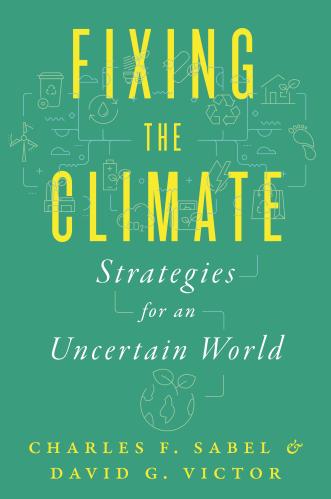Compared with just five years ago, the world has made tremendous advances on the climate issue, but the strategies for achieving cooperation are still a work in progress. David Victor argues for the useful role that subnational efforts, through “three-dimensional” clubs, can play in jump-starting the process of putting the Paris Agreement into effect. But the talking about such clubs must now shift to doing. The International Centre for Trade and Sustainable Development originally published this piece.
For all the talk about policy action to address climate change, there are still many inconvenient truths as firms and governments are wary of imposing costly obligations that hurt economic competitiveness. Indeed, new research suggests that the industrialized world is not on track to meet the pledges it made in Paris, and the U.S. government surely has not helped matters by announcing it will pull out of Paris.
These kinds of problems have led many analysts, including myself, to be pessimistic about just how much progress can be made through global cooperation. Despite this, progress is possible, yet in smaller groups—often called clubs. At ICTSD [International Centre for Trade and Sustainable Development] over the last few years we have published a series of essays on the merits of club-based cooperation (for example here, here, here and here). And recently I’ve published a paper with ICTSD that takes the argument one step further by looking at clubs that are not just arrayed two-dimensionally with members drawn from the various national governments that spatially cover the planet. The new essay makes the case for “three-dimensional” (3D) clubs—that is, clubs of actors operating at levels below the national government—as well as those that work in tandem across nations, most notably multinational firms and NGOs.
What role for 3D clubs?
The advantages of 3D clubs are many. By working around national governments, these clubs may be able to pursue bolder goals and engage the players who actually have the biggest leverage on emissions (the new essay focuses on 3D clubs for mitigation—that is, controlling emissions—but a similar logic is also compelling for climate adaptation and perhaps even geoengineering). National governments must keep many objectives and political pressures in mind, which can make them risk averse. By picking and choosing the actors who are most willing to act, 3D clubs could help demonstrate much more quickly how serious climate policies can evolve.
Indeed, it looks like there are many such 3D clubs already emerging, which suggests that it should not be so hard to predict their existence let alone identify functions they could perform. Working through all the potential functions suggests that 3D clubs could fill in many of the gaps that national governments have left. They could, in short, jump-start and radically accelerate the process of putting the Paris Agreement into effect.
In reality, however, it is not so clear what all these groups are actually doing. Three-dimensional clubs—perhaps even more than traditional clubs of national governments—can easily become talk shops. Indeed, so far it is hard to see that today’s 3D clubs have achieved much beyond issuing bold statements—with some notable exceptions, such as in palm oil-related work and for some energy technologies.
Moving beyond talk shops
A lot more attention is needed to figure out which clubs are actually generating real, additional action. Doing that will require efforts on three fronts.
First, under the Paris Agreement, much more work is needed to flesh out Article 6, which encourages a wide range of cooperative efforts—including clubs. A portal is being set up to document various subnational efforts to advance the goals of the Paris Agreement—that is, 3D climate clubs. This is a start, but much more attention is needed to quantifying the benefits of these smaller clubs.
Second, key national governments and subnational actors need to lead. The bottom-up framework of the Paris Agreement is a plausible way to make progress on the climate problem. But it is not a guarantee. Many key elements of the Paris framework remain to be fleshed out, and it will be hard to get universal agreement on the best approaches. Leadership that demonstrates the best approaches—and thus changes the debate with facts on the ground—is essential. Leaders within subnational clubs should spend less time focused on making bold claims for what they will do and more on demonstrating, practically, how their efforts are adding value.
Third, the intergovernmental process can help as well. Particularly promising is the fresh attention to climate change through the G20—thanks, in part, to the wavering support by the United States, which has inspired most other G20 members to emphasize the importance of this topic.
Window for intergovernmental engagement
A supportive G20 host could easily strengthen club-based cooperation by inviting potential 3D club members to present their plans in the context of a G20 summit—probably at a side event so that the activity would not require the full formal consent of all G20 members, notably the United States where the formal national government is now so averse to serious engagement on this topic. Argentina, host of the G20 in 2018, could do this by engaging the B20 and T20 (leading businesses and think tanks) to report on how subnational action on climate change could be accelerated—along with an outline for helping to make these subnational efforts more accountable so that real additional actions can be distinguished from mere talking. For Argentina this effort might, as well, focus on areas of particular interest to that country—such as how to integrate more renewables into the power grid, promote investment in energy efficiency, and take advantage of cleaner burning natural gas (Argentina’s geology includes prodigious amounts of shale gas that are yet to be tapped). This approach could offer the advantage of intergovernmental engagement, including the ability to draw upon resources available to sympathetic national governments.
Compared with just five years ago the world has made tremendous progress on the climate issue. But the basic logic of climate change has not changed—cooperation, eventually deep cooperation, will be needed. And the strategies for achieving that cooperation are still a work in progress. More investment in clubs can help turn that promise into a reality, and 3D clubs in particular have a useful role to play. But the talking about clubs must now shift to doing.
This article is derived from paper Three-Dimensional Climate Clubs: Implications for Climate Cooperation and the G20 authored by David Victor and published by ICTSD.










Commentary
Jump-starting and accelerating the implementation of the Paris Agreement
August 31, 2017